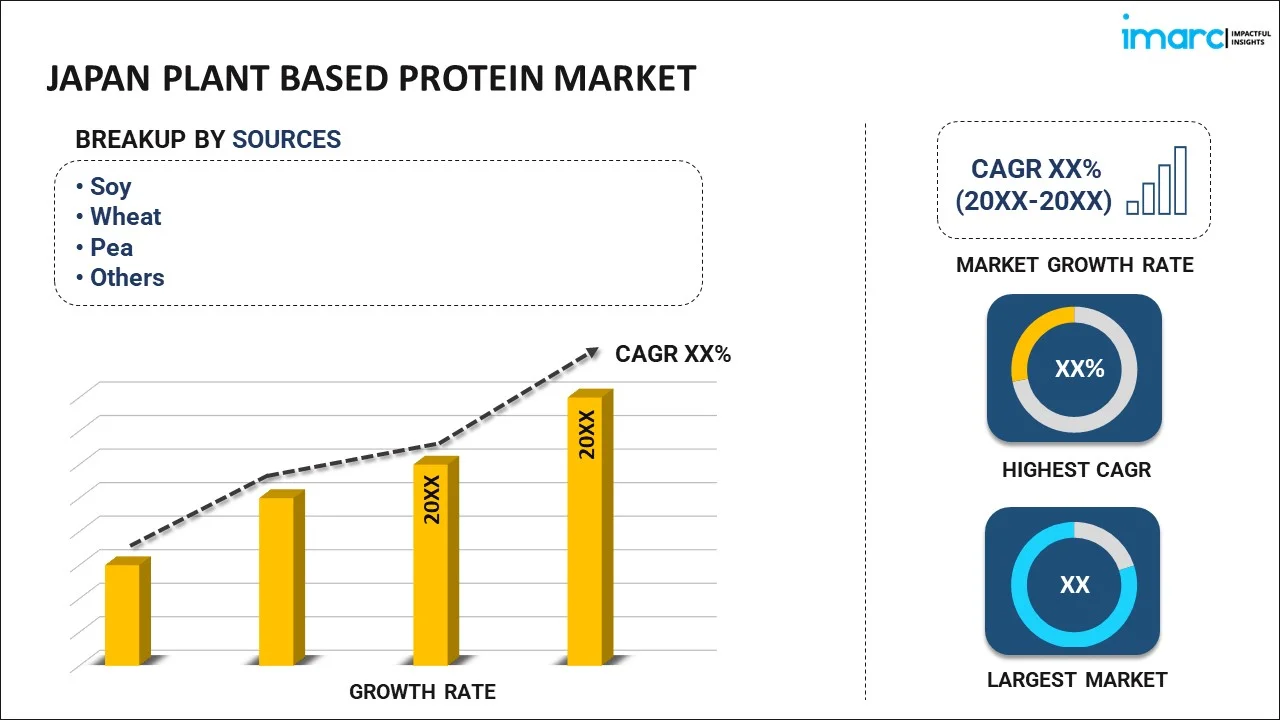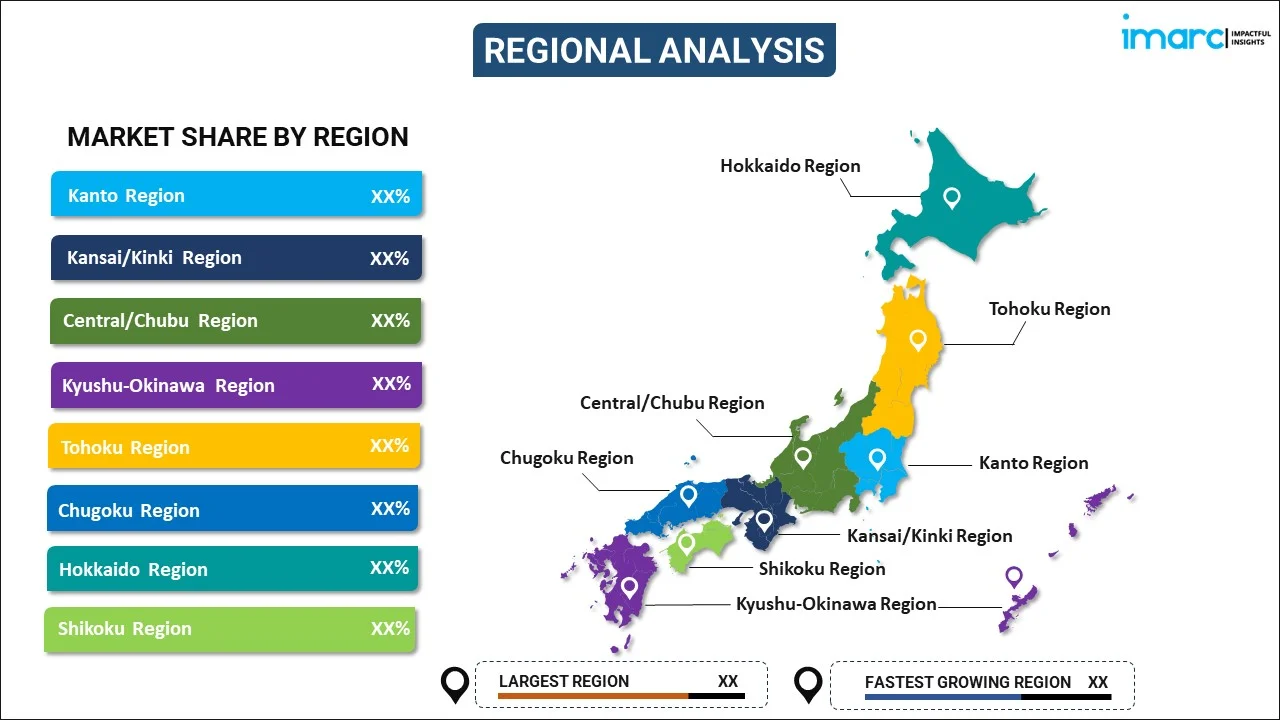
Japan Plant Based Protein Market Report by Source (Soy, Wheat, Pea, and Others), Type (Concentrates, Isolates, Textured), Nature (Conventional, Organic), Application (Food, Feed), and Region 2025-2033
Market Overview:
Japan plant based protein market size reached USD 696.3 Million in 2024. Looking forward, IMARC Group expects the market to reach USD 1,346.2 Million by 2033, exhibiting a growth rate (CAGR) of 7.2% during 2025-2033. The elevating need for environmental sustainability, along with the rising number of health-conscious individuals, is primarily driving the market growth.
|
Report Attribute
|
Key Statistics
|
|---|---|
|
Base Year
|
2024
|
|
Forecast Years
|
2025-2033
|
|
Historical Years
|
2019-2024
|
| Market Size in 2024 | USD 696.3 Million |
| Market Forecast in 2033 | USD 1,346.2 Million |
| Market Growth Rate 2025-2033 | 7.2% |
Plant-based protein refers to a category of dietary protein sources derived exclusively from plants, excluding animal-based sources like meat, dairy, and eggs. These plant-derived proteins are obtained from various plant foods such as legumes (e.g., beans, lentils, and chickpeas), grains (e.g., wheat, rice, and quinoa), nuts (e.g., almonds and peanuts), seeds (e.g., chia and flaxseeds), and certain vegetables (e.g., broccoli and spinach). Plant-based protein has gained significant popularity due to its numerous health benefits, environmental sustainability, and alignment with various dietary preferences, including vegetarianism, veganism, and flexitarianism. It offers a valuable source of essential amino acids, vitamins, minerals, and dietary fiber, making it a nutritious and versatile option for individuals seeking to meet their protein needs while adhering to plant-centric or sustainable diets. Consequently, it is gaining traction across Japan.
Japan Plant Based Protein Market Trends:
The Japan plant-based protein market is experiencing a remarkable surge in growth, reflecting changing dietary preferences and increased awareness of health and sustainability. As part of a broader trend, Japan has witnessed a growing shift towards plant-based diets due to concerns about health, environmental sustainability, and animal welfare. Additionally, this shift has led to an increased demand for plant-based protein sources derived from legumes, grains, nuts, seeds, and vegetables, which is positively influencing the regional market. Besides this, the Japanese market is witnessing the introduction of a diverse range of plant-based protein products, including plant-based meat substitutes, dairy alternatives, protein-rich snacks, and plant-based protein powders, thereby acting as another significant growth-inducing factor. This expanding array of options caters to the preferences of consumers, including vegetarians, vegans, and flexitarians, who seek to incorporate more plant-based proteins into their diets. The rise in health-consciousness and environmental awareness, coupled with a surge in product innovation, positions the Japan plant-based protein market for continued growth and adaptation to evolving consumer demands.
Japan Plant Based Protein Market Segmentation:
IMARC Group provides an analysis of the key trends in each segment of the market, along with forecasts at the country level for 2025-2033. Our report has categorized the market based on source, type, nature, and application.
Source Insights:

- Soy
- Wheat
- Pea
- Others
The report has provided a detailed breakup and analysis of the market based on the source. This includes soy, wheat, pea, and others.
Type Insights:
- Concentrates
- Isolates
- Textured
A detailed breakup and analysis of the market based on the type have also been provided in the report. This includes concentrates, isolates, and textured.
Nature Insights:
- Conventional
- Organic
The report has provided a detailed breakup and analysis of the market based on the nature. This includes conventional and organic.
Application Insights:
- Food
- Meat Alternatives
- Dairy Alternatives
- Bakery Products
- Performance Nutrition
- Convenience Foods
- Others
- Feed
A detailed breakup and analysis of the market based on the application have also been provided in the report. This includes food (meat alternatives, dairy alternatives, bakery products, performance nutrition, convenience foods, and others) and feed.
Regional Insights:

- Kanto Region
- Kansai/Kinki Region
- Central/ Chubu Region
- Kyushu-Okinawa Region
- Tohoku Region
- Chugoku Region
- Hokkaido Region
- Shikoku Region
The report has also provided a comprehensive analysis of all the major regional markets, which include Kanto Region, Kansai/Kinki Region, Central/ Chubu Region, Kyushu-Okinawa Region, Tohoku Region, Chugoku Region, Hokkaido Region, and Shikoku Region.
Competitive Landscape:
The market research report has also provided a comprehensive analysis of the competitive landscape in the market. Competitive analysis such as market structure, key player positioning, top winning strategies, competitive dashboard, and company evaluation quadrant has been covered in the report. Also, detailed profiles of all major companies have been provided.
Japan Plant Based Protein Market Report Coverage:
| Report Features | Details |
|---|---|
| Base Year of the Analysis | 2024 |
| Historical Period | 2019-2024 |
| Forecast Period | 2025-2033 |
| Units | Million USD |
| Scope of the Report | Exploration of Historical Trends and Market Outlook, Industry Catalysts and Challenges, Segment-Wise Historical and Future Market Assessment:
|
| Sources Covered | Soy, Wheat, Pea, Others |
| Types Covered | Concentrates, Isolates, Textured |
| Natures Covered | Conventional, Organic |
| Applications Covered |
|
| Regions Covered | Kanto Region, Kansai/Kinki Region, Central/ Chubu Region, Kyushu-Okinawa Region, Tohoku Region, Chugoku Region, Hokkaido Region, Shikoku Region |
| Customization Scope | 10% Free Customization |
| Post-Sale Analyst Support | 9-11 Weeks |
| Delivery Format | PDF and Excel through Email (We can also provide the editable version of the report in PPT/Word format on special request) |
Key Questions Answered in This Report:
- How has the Japan plant based protein market performed so far and how will it perform in the coming years?
- What has been the impact of COVID-19 on the Japan plant based protein market?
- What is the breakup of the Japan plant based protein market on the basis of source?
- What is the breakup of the Japan plant based protein market on the basis of type?
- What is the breakup of the Japan plant based protein market on the basis of nature?
- What is the breakup of the Japan plant based protein market on the basis of application?
- What are the various stages in the value chain of the Japan plant based protein market?
- What are the key driving factors and challenges in the Japan plant based protein?
- What is the structure of the Japan plant based protein market and who are the key players?
- What is the degree of competition in the Japan plant based protein market?
Key Benefits for Stakeholders:
- IMARC’s industry report offers a comprehensive quantitative analysis of various market segments, historical and current market trends, market forecasts, and dynamics of the Japan plant based protein market from 2019-2033.
- The research report provides the latest information on the market drivers, challenges, and opportunities in the Japan plant based protein market.
- Porter's five forces analysis assist stakeholders in assessing the impact of new entrants, competitive rivalry, supplier power, buyer power, and the threat of substitution. It helps stakeholders to analyze the level of competition within the Japan plant based protein industry and its attractiveness.
- Competitive landscape allows stakeholders to understand their competitive environment and provides an insight into the current positions of key players in the market.
Need more help?
- Speak to our experienced analysts for insights on the current market scenarios.
- Include additional segments and countries to customize the report as per your requirement.
- Gain an unparalleled competitive advantage in your domain by understanding how to utilize the report and positively impacting your operations and revenue.
- For further assistance, please connect with our analysts.
 Inquire Before Buying
Inquire Before Buying
 Speak to an Analyst
Speak to an Analyst
 Request Brochure
Request Brochure
 Request Customization
Request Customization




.webp)




.webp)












